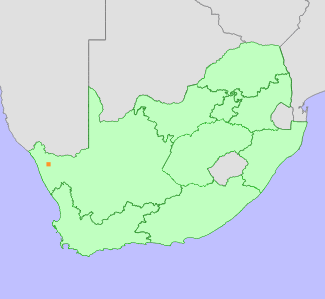|
Scientific Name | Conophytum crateriforme A.J.Young, Rodgerson, Harrower & S.A.Hammer |
Higher Classification | Dicotyledons |
Family | AIZOACEAE |
National Status |
Status and Criteria | Critically Endangered A4d; B1ab(iii,v); D |
Assessment Date | 2021/11/19 |
Assessor(s) | A.J. Young, P.G. Desmet, I. Ebrahim, D. Guo, A. Harrower, L. Jabar, L. Knoetze, C. Rodgerson, P.C.V. Van Wyk & N.N. Mhlongo |
Justification | This succulent is endemic to the Northern Cape province of South Africa where it is only recorded from a single locality with an extent of occurrence (EOO) and area of occupancy (AOO) of 12 km². Loss of vegetation cover at this site indicates a decline in habitat quality. The population is in severe decline with approximately 95% of mature individuals of this species removed from habitat in 2021 to supply the international trade in ornamental succulents. The single location means that the few remaining plants are at severe risk and a complete decline of up to 100% of the population is likely within the next 10 years. Climate change is also impacting the population although there is uncertainty of the response given the expected resilience of this taxon. It therefore qualifies as Critically Endangered under criteria A2+4, B1 and D. |
Distribution |
Endemism | South African endemic |
Provincial distribution | Northern Cape |
Range | This species is endemic to a small part of the Northern Cape province of South Africa where it is only found in a single location with a restricted geographic range. |
Habitat and Ecology |
Major system | Terrestrial |
Major habitats | Succulent Karoo |
Description | This species is endemic to the Succulent Karoo biome (Richtersveld bioregion). Plants are found in sheltered areas of partial shade of large rocks and ridges and are highly localised. This species has a generation length of 30 years. It is expected to be sensitive to the impacts of climate change as it does not disperse and while adapted to arid conditions, is dependent on limited seasonal rainfall. Species in the genus are sensitive to long periods of drought. Drought related mortality has been observed for other closely related taxa within the genus. |
Threats |
| This taxon is currently threatened by illegal collection for the succulent trade and the majority of plants were removed from habitat in 2021. Illegal collection threatens the few remaining mature individuals. The single location makes the very small population very susceptible to rapid declines as a result of illegal collection.
Anthropogenic climate change is a long-term threat to this species. Loss of vegetation cover has been observed at this site via Landsat imagery between 1984 and 2018 and is used to infer that the habitat quality is already in decline. While it is not possible to model the response of this species to climate change due to its restricted distribution, the average loss to climate change for 15 more widely distributed Conophytum species occurring within the same region is used as an indication of likely impact to this species. Climate models for the likely emission scenarios where emissions stay at present day levels (RCP 2.6) (Hausfather and Peters 2020) and worst case scenarios where emissions continue to increase during the 21st century (RCP 8.5) indicate that there will be a loss of suitable bioclimatic envelope of between 72% and 99% by 2080 for Conophytum taxa within the region. However, as this species occupies a very sheltered habitat it is expected to have a level of resilience to climate change and the expected population loss is reduced by 20% to 52% based on the uncertainty of the response given the expected resilience of this taxon. |
Population |
The small population of plants at the only known locality has experienced a very rapid decline in 2021. Initial population estimates suggested up to 500 mature individuals may be present but fewer than 25 mature individuals were recorded from the only known location as a result of a site survey by SANBI in 2021.
|
Population trend | Decreasing |
Bibliography |
Hammer, S. 2002. Dumpling and his wife: New view of the genus Conophytum. EAE Creative Colour, Norwich.
Hammer, S.A. 1993. The genus Conophytum: A conograph. Succulent Plant Publications, Pretoria.
Hausfather, Z. and Peters, G.P. 2020. Emissions - the 'business as usual' story is misleading. Nature 577(618-620).
|
Citation |
| Young, A.J., Desmet, P.G., Ebrahim, I., Guo, D., Harrower, A., Jabar, L., Knoetze, L., Rodgerson, C., Van Wyk, P.C.V. & Mhlongo, N.N. 2021. Conophytum crateriforme A.J.Young, Rodgerson, Harrower & S.A.Hammer. National Assessment: Red List of South African Plants version 2024.1. Accessed on 2025/12/02 |
 Comment on this assessment
Comment on this assessment

